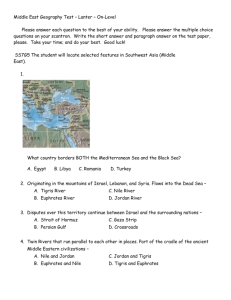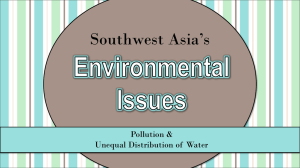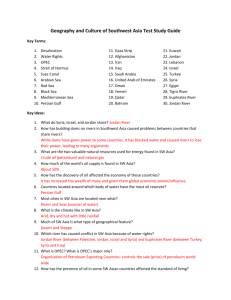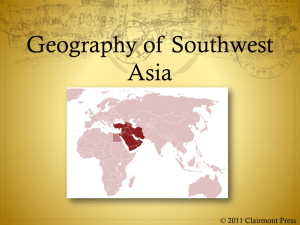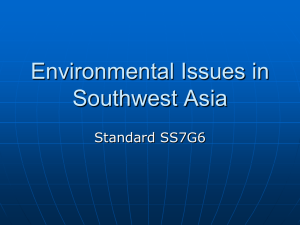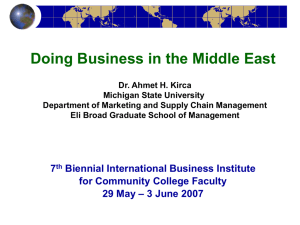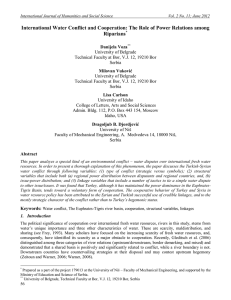PPT and Writing Organizer
advertisement
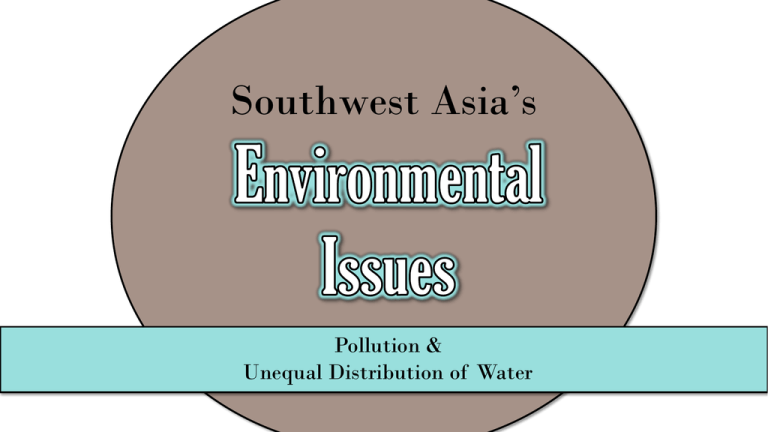
Southwest Asia’s Pollution & Unequal Distribution of Water Standards SS7G6 The student will discuss environmental issues across Southwest Asia (Middle East). a. Explain how water pollution and the unequal distribution of water impacts irrigation and drinking water. Essential Question How do water pollution and the unequal distribution of water impact irrigation and drinking water in the Middle East? • Irrigation - To supply (dry land) with water by means of ditches, pipes, or streams; water artificially. • Desalination – the process of removing salt and other chemicals from seawater • Hydroelectric power – electricity produced from the energy of running water • Unequal distribution 3 major river systems Euphrates River • runs through Turkey, Syria, Iraq, and Kuwait Tigris River • runs through Turkey, Iraq, and Kuwait Jordan River • part of the border of Syria, Jordan, the West Bank, and Israel Why are rivers important? • Water for drinking • Water for irrigation • Water for transportation and trade • Boundaries between nations • Major cities are located on or near these rivers – centers of industry (jobs) • Many countries in Southwest Asia are experiencing the increasing problem of water pollution. • Farmers have begun using chemical fertilizers that run off from the fields and contaminate water supplies. • Chemicals also lead to salt build-up in the soil, which eventually makes farming in those areas impossible. • Rapid growth of industry in cities and towns has caused garbage and sewage to build up in rivers and streams. • Iraq also faces water pollution problems as a result of industry and petroleum drilling equipment. • Also, three decades of warfare have caused damage to Iraq’s water treatment plants. Tigris River Pollution • Saudi Arabia has a desert climate and has struggled to meet the water needs of its growing population. • Water is scarce in the country, and what little water that is available is of poor quality because of salt water intrusion. • The country has built a number of desalination plants that provide most of the country’s drinking water. • Desalination is the process of taking salt out of seawater and using it for drinking water. World’s Largest Desalination Plant – Jubail Industrial City, Saudi Arabia • Water availability is a major concern in Southwest Asia. • Less than 1% of the world’s fresh water is available to the area’s inhabitants (5% of the world’s population). • There is simply not enough water available to meet the population’s needs. • Middle Eastern countries are constantly in conflict over these water problems. • Let’s take a look at how water is distributed in several of these countries. “Many of the wars of this century were about oil, but the wars of the next century will be about water.” - Former World Bank Vice President Ismail Sergeldin Water availability in Iraq will halve by 2050 • Turkey has a “water advantage” over other Middle Eastern countries because the Tigris and Euphrates rivers form in the country’s highlands. highlands. • Turkey has developed the Southeastern Anatolia Project, which consists of 22 dams and 19 hydroelectric plants along the Euphrates River. • This project has greatly improved the standard of living for Turkey’s citizens. • Unfortunately, the country has had to deal with the increasing problem of water pollution. • In addition to chemical fertilizers and industrial wastes, the rivers have also been affected by oil spills in the Black Sea. Ataturk Dam -- Turkey • The dams that Turkey built along the Euphrates have greatly reduced the amount of water reaching Syria (40% less). • Syria already suffers from food shortages, and irrigating new land is extremely difficult with the diminished water supply from the Euphrates. • In order to keep some water in the country, Syria has also built dams along the river. • This has reduced the river’s flow into Iraq, thus causing more conflict. Lake Assad – Syria’s largest reservoir was created in 1974 • The dams that Turkey & Syria built along the Euphrates have also greatly reduced the amount of water reaching Iraq (80% less). • This has negatively impacted the country’s food supply. • Wheat & rice production has decreased dramatically, and many farmers are now without jobs. • Since its creation in 1948, Israel has developed new technology and advanced farming techniques that have turned the oncebarren desert land into farmland. • Because rainfall is down, Israel has to rely on drawing water from its aquifers (underground layer of rock and sand that contains water). • Unfortunately, the aquifers are in jeopardy because more water is taken out than is replenished by rain. • Israel has been involved in many conflicts over water rights to the Jordan River with Syria, Jordan, and Palestine. National Water Carrier of Israel – pipeline that transfers water from the Sea of Galilee to the highly populated center and arid south • Jordan is one of the ten most water scarce countries in the world. • The country’s major surface water sources are shared with Israel and Syria, who leave only a small amount for Jordan. • Israel has built pipelines that redirect the river’s water away from Jordan Jordan and into its own lands. • Jordan & Israel have been involved in military battles over water rights. • Jordan cannot meet the basic needs of its people and has to ration the water supply. • Citizens can only get water two days a week. Mujib Dam, Jordan – desalinates brackish water from the Dead Sea Description of Resource: Uses: (Definition) Where it is found in the Middle East: The most important natural resources is_______________ Why it is important: because… Economic Impact Environmental Impact Negatives Using the organizer you created, write on paragraph explaining why the resources you chose (oil or water) is the most important to the Middle East.
